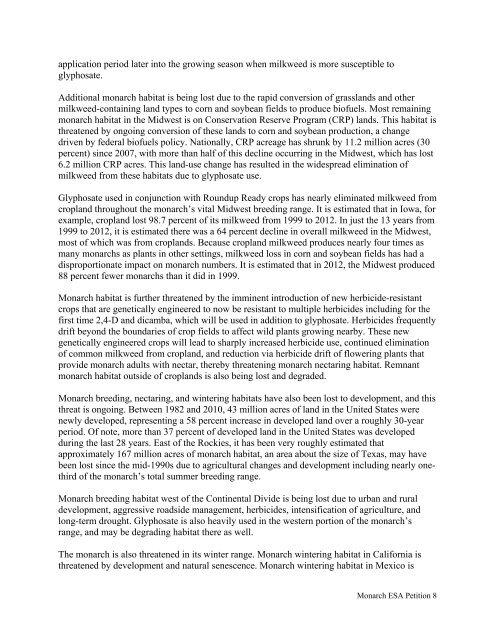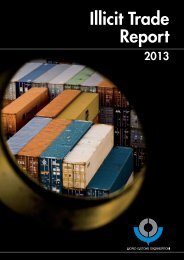monarch-esa-petition-final_61585
monarch-esa-petition-final_61585
monarch-esa-petition-final_61585
You also want an ePaper? Increase the reach of your titles
YUMPU automatically turns print PDFs into web optimized ePapers that Google loves.
application period later into the growing season when milkweed is more susceptible to<br />
glyphosate.<br />
Additional <strong>monarch</strong> habitat is being lost due to the rapid conversion of grasslands and other<br />
milkweed-containing land types to corn and soybean fields to produce biofuels. Most remaining<br />
<strong>monarch</strong> habitat in the Midwest is on Conservation Reserve Program (CRP) lands. This habitat is<br />
threatened by ongoing conversion of these lands to corn and soybean production, a change<br />
driven by federal biofuels policy. Nationally, CRP acreage has shrunk by 11.2 million acres (30<br />
percent) since 2007, with more than half of this decline occurring in the Midwest, which has lost<br />
6.2 million CRP acres. This land-use change has resulted in the widespread elimination of<br />
milkweed from these habitats due to glyphosate use.<br />
Glyphosate used in conjunction with Roundup Ready crops has nearly eliminated milkweed from<br />
cropland throughout the <strong>monarch</strong>’s vital Midwest breeding range. It is estimated that in Iowa, for<br />
example, cropland lost 98.7 percent of its milkweed from 1999 to 2012. In just the 13 years from<br />
1999 to 2012, it is estimated there was a 64 percent decline in overall milkweed in the Midwest,<br />
most of which was from croplands. Because cropland milkweed produces nearly four times as<br />
many <strong>monarch</strong>s as plants in other settings, milkweed loss in corn and soybean fields has had a<br />
disproportionate impact on <strong>monarch</strong> numbers. It is estimated that in 2012, the Midwest produced<br />
88 percent fewer <strong>monarch</strong>s than it did in 1999.<br />
Monarch habitat is further threatened by the imminent introduction of new herbicide-resistant<br />
crops that are genetically engineered to now be resistant to multiple herbicides including for the<br />
first time 2,4-D and dicamba, which will be used in addition to glyphosate. Herbicides frequently<br />
drift beyond the boundaries of crop fields to affect wild plants growing nearby. These new<br />
genetically engineered crops will lead to sharply increased herbicide use, continued elimination<br />
of common milkweed from cropland, and reduction via herbicide drift of flowering plants that<br />
provide <strong>monarch</strong> adults with nectar, thereby threatening <strong>monarch</strong> nectaring habitat. Remnant<br />
<strong>monarch</strong> habitat outside of croplands is also being lost and degraded.<br />
Monarch breeding, nectaring, and wintering habitats have also been lost to development, and this<br />
threat is ongoing. Between 1982 and 2010, 43 million acres of land in the United States were<br />
newly developed, representing a 58 percent increase in developed land over a roughly 30-year<br />
period. Of note, more than 37 percent of developed land in the United States was developed<br />
during the last 28 years. East of the Rockies, it has been very roughly estimated that<br />
approximately 167 million acres of <strong>monarch</strong> habitat, an area about the size of Texas, may have<br />
been lost since the mid-1990s due to agricultural changes and development including nearly onethird<br />
of the <strong>monarch</strong>’s total summer breeding range.<br />
Monarch breeding habitat west of the Continental Divide is being lost due to urban and rural<br />
development, aggressive roadside management, herbicides, intensification of agriculture, and<br />
long-term drought. Glyphosate is also heavily used in the western portion of the <strong>monarch</strong>’s<br />
range, and may be degrading habitat there as well.<br />
The <strong>monarch</strong> is also threatened in its winter range. Monarch wintering habitat in California is<br />
threatened by development and natural senescence. Monarch wintering habitat in Mexico is<br />
Monarch ESA Petition 8




